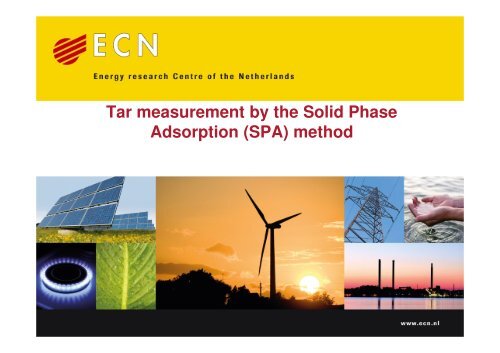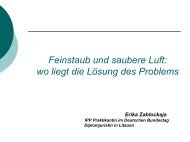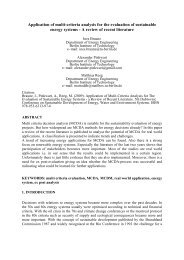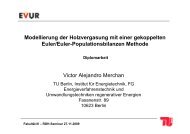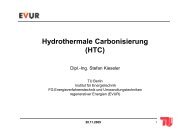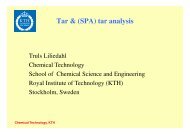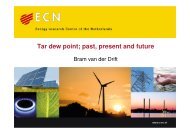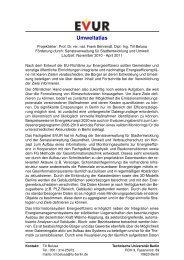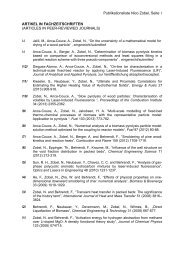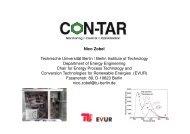Tar measurement by the Solid Phase Adsorption (SPA ... - EVUR
Tar measurement by the Solid Phase Adsorption (SPA ... - EVUR
Tar measurement by the Solid Phase Adsorption (SPA ... - EVUR
Create successful ePaper yourself
Turn your PDF publications into a flip-book with our unique Google optimized e-Paper software.
<strong>Tar</strong> <strong>measurement</strong> <strong>by</strong> <strong>the</strong> <strong>Solid</strong> <strong>Phase</strong><br />
<strong>Adsorption</strong> (<strong>SPA</strong>) method<br />
www.ecn.nl
2 29-6-2011<br />
Introduction<br />
• Measurement of biomass tars after gasifier/gas clean-up,<br />
easy to use, low cost up to analysis<br />
• Guideline method too cumbersome, only used <strong>by</strong> gasification<br />
3 29-6-2011<br />
Sampling<br />
• 100 ml gas at constant flow rate <strong>by</strong> automated syringe pump<br />
• Sample syringe attached to pump <strong>by</strong> short tube<br />
• Type of <strong>SPA</strong>: LC-NH2 (aminopropyl), 100mg<br />
• Flow rate: 50 ml/min
4 29-6-2011<br />
Sample treatment<br />
BTEX -<br />
Adsorp Desorp GC<br />
Phenol -<br />
MW>300 -<br />
• Volatile compounds (BTEX) are not 100% captured (pass<br />
through adsorbent, we use micro-GC for Benzene &<br />
Toluene)<br />
• Oxygenated compounds (phenol, cresols) are recovered<br />
from <strong>the</strong> <strong>SPA</strong><br />
• N PAHs ((iso)quinoline) & PAHs without hetero-atoms<br />
(napthalene, fluorene, phenanthrene, anthracene, pyrene)<br />
are recovered<br />
• Analyse within few hours: BTEX suffer, rest within 15%<br />
• Storage @ -20°C to prevent evaporation from <strong>SPA</strong>, BTEX is<br />
lost, indene & phenol is slightly lost after 2 months<br />
• Both column & needle are flushed with 2 x 1ml DCM
5 29-6-2011<br />
GC analysis<br />
• Hot split injection on non polar GC column<br />
• Detection with FID (Flame Ionization Detector)<br />
• Calibration via internal standard (n-dodecane)<br />
• Detection limit is 2.5 mg/m3 for 100 ml gas sample<br />
• 33 compounds identified, o<strong>the</strong>r peaks labelled as ‘Unknowns’<br />
& classified in 5 groups according to elution on <strong>the</strong> GC<br />
column
6 29-6-2011<br />
GC analysis<br />
• Groups ‘Unknowns’:<br />
- 1 Benzene to naphtalene<br />
- 2 Napthalene to phenantrene<br />
- 3 Phenanthrene to pyrene<br />
- 4 Pyrene to benzo(e)pyrene<br />
- 5 Benzo(e)pyrene to end
7 29-6-2011<br />
GC analysis<br />
• Identified compounds<br />
• Benzene<br />
• 2-methyl-naphthalene<br />
• Benzo(a)-anthracene<br />
• Toluene<br />
• 1-methyl-naphthalene<br />
• Chrysene<br />
• Ethylbenzene<br />
• Biphenyl<br />
• Benzo(b)-fluoran<strong>the</strong>ne<br />
• m/p-Xylene<br />
• E<strong>the</strong>nyl-naphthalene<br />
• Benzo(k)-fluoran<strong>the</strong>ne<br />
• o-Xylene+Styrene<br />
• Acenaphtylene<br />
• Benzo(e)-pyrene<br />
• Phenol<br />
• Acenaphtene<br />
• Benzo(a)-pyrene<br />
• Indene+o-cresol<br />
• Fluorene<br />
• Perylene<br />
• m/p-Cresol<br />
• Phenanthrene<br />
• Indeno(123-cd)perylene<br />
• Naphthalene<br />
• Anthracene<br />
• Dibenz(ah)anthracene<br />
• Quinoline<br />
• Fluoran<strong>the</strong>ne<br />
• Benzo(ghi)-perylene<br />
• Isoquinoline<br />
• Pyrene<br />
• Coronene
8 29-6-2011<br />
GC analysis<br />
• ECN tar clasification system<br />
Class 1<br />
Class 2<br />
Class 3<br />
Class 4<br />
Class 5<br />
GC undetectable tars. This class includes <strong>the</strong><br />
heaviest tars that condense at high temperature<br />
even at very low concentrations.<br />
Heterocyclic components (like phenol, pyridine,<br />
cresol). These are components that generally<br />
exhibit high water solubility, due to <strong>the</strong>ir polarity.<br />
Aromatic components. Light hydrocarbons that<br />
are not important in condensation and water<br />
solubility issues.<br />
Light polyaromatic hydrocarbons (2-3 rings<br />
PAH’s). These components condense at relatively<br />
high concentrations and intermediate<br />
temperatures.<br />
Heavy polyaromatic hydrocarbons (4-5 rings<br />
PAH’s). These components condense at relatively<br />
high temperature at low concentrations.
9 29-6-2011<br />
Evaluation of tar results<br />
• Concentration of tar in a gas is a <strong>the</strong>rmodynamic equilibrium.<br />
• For most of <strong>the</strong> 33 <strong>SPA</strong> tar components this vapour pressure<br />
data is known.<br />
• The Antoine equation is used to determine for a mixture what<br />
<strong>the</strong> temperature is to keep all tar molecules in <strong>the</strong> gas phase.
10 29-6-2011<br />
Model considerations<br />
Advantages<br />
• Model is a quick and simple<br />
to use<br />
• Provides insight in <strong>the</strong><br />
behavior of gas cleaning<br />
• Takes mixtures into<br />
account.<br />
• Verified with actual<br />
measured tar dew points<br />
Disadvantages<br />
• Limited to <strong>the</strong> range of<br />
input data (
11 29-6-2011<br />
Considerations<br />
• <strong>SPA</strong> warms up during sampling period: BTEX, Indeen and 1ring<br />
sulphur compounds not quantitavely recovered<br />
• Sulphur compounds are measured <strong>by</strong> GC-FID on <strong>the</strong> lab<br />
• O<strong>the</strong>r adsorbents: maybe a C18, fenyl phase or carbon like<br />
materials recovers BTEX and PAHs better but eluting may<br />
be more difficult<br />
• Blanc interference can be improved<br />
• In combination met de micro-GC & GC-FID on <strong>the</strong> lab, we<br />
are satisfied with <strong>the</strong> current <strong>SPA</strong> method
12 29-6-2011<br />
Questions?<br />
• For more information: a.grootjes@ecn.nl


